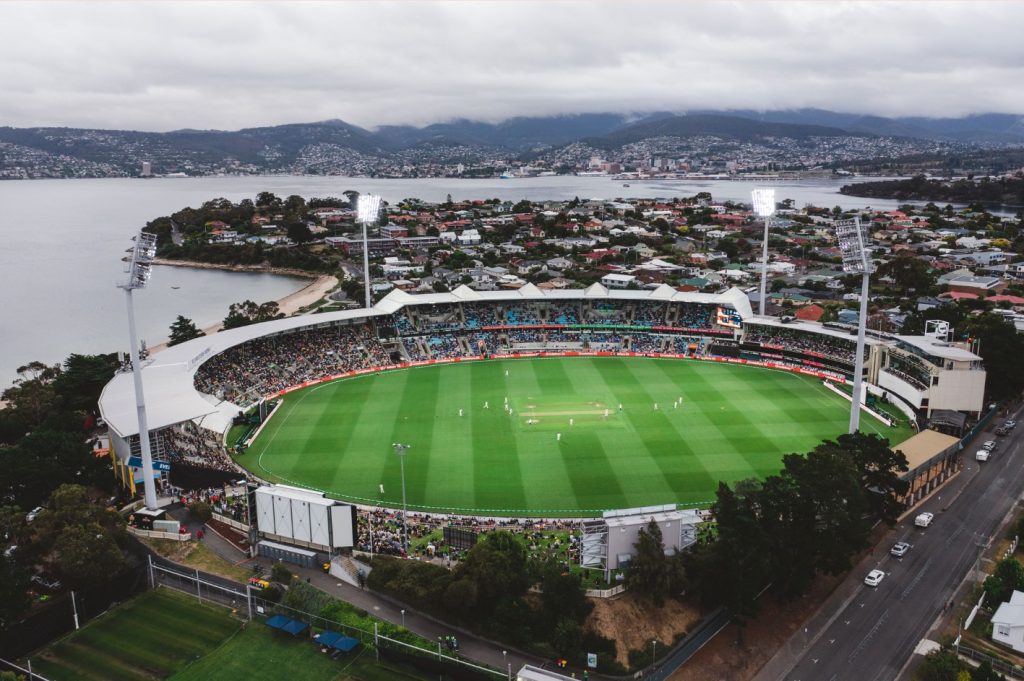Hobart Cricket Ground: Cricket, unlike most sports, is played on fields with non-standard dimensions. While the pitch in the center maintains a universal length of 22 yards (20.12 meters), the boundary dimensions—the distance from the center of the pitch to the edge of the playing field—can vary significantly from one ground to another. This flexibility adds a layer of uniqueness and challenge to each venue.
Table of Contents
One such distinctive venue is the Bellerive Oval, popularly known as the Blundstone Arena, located in Hobart, Tasmania. This stadium, although relatively modest in size compared to international behemoths like the Melbourne Cricket Ground (MCG), offers unique dimensions and conditions that impact how the game is played.
Overview of Hobart Cricket Ground (Blundstone Arena)
| Feature | Details |
|---|---|
| Ground Name | Blundstone Arena (Bellerive Oval) |
| Location | Hobart, Tasmania, Australia |
| Established | 1914 |
| Capacity | Approximately 20,000 |
| Ends | River End, Church Street End |
| First International Match | Test – 1989, ODI – 1988 |
Blundstone Arena is Tasmania’s primary international cricket ground. With scenic views and a moderate spectator capacity, it plays host to both international fixtures and Big Bash League (BBL) matches.
Boundary Lengths at Hobart Cricket Ground
Average Boundary Distances by Direction
| Direction | Distance (in meters) | Type |
|---|---|---|
| Straight | 75–80 meters | Long boundary |
| Square (Off/Leg) | 65–70 meters | Medium boundary |
| Fine leg | 60–65 meters | Short boundary |
| Third man | 60–65 meters | Short boundary |
| Deep mid-wicket | 70–75 meters | Medium-long |
| Cover | 70–75 meters | Medium-long |
These figures can slightly vary depending on the specific boundary ropes used for different matches, as ICC regulations allow the use of inner boundary ropes to increase player safety.
How Boundary Sizes Affect Match Outcomes
Boundary dimensions directly influence the nature of play, especially in limited-overs formats like ODIs and T20s. Here’s how Hobart’s layout affects different aspects of the game:
1. Batting Strategy
- Smaller square boundaries on one side make it favorable for aggressive players to target these areas.
- Power hitters often adjust their stance to take advantage of shorter sides, especially in T20s.
- The longer straight boundaries challenge batters who rely on lofted shots over the bowler’s head.
2. Bowling Tactics
- Bowlers, especially spinners and medium pacers, tend to bowl wider lines to force batters into hitting toward the longer boundaries.
- Fast bowlers use fuller deliveries and change-ups to induce mistimed shots aimed toward the longer straight boundary.
3. Fielding Positions
- Captains adjust boundary riders depending on wind conditions and batter preferences.
- Extra protection is usually placed on the side with shorter boundaries, particularly during powerplays and death overs.
Historical Matches & Boundary Influence
Several matches at Blundstone Arena have illustrated how the ground’s dimensions shape match dynamics:
High-Scoring Matches at Hobart
| Match | Year | Total Runs Scored | Notable Performance |
|---|---|---|---|
| Australia vs England (ODI) | 2011 | 616 | Jonathan Trott – 137* |
| Hurricanes vs Renegades | 2017 | 438 | D’Arcy Short – 122* |
| Australia vs India (T20I) | 2023 | 400 | Glenn Maxwell – 104* |
These games saw aggressive scoring largely due to the ability to exploit shorter boundaries and the quick outfield.
Comparisons with Other Australian Grounds
Let’s compare Hobart’s boundary sizes with other major Australian venues:
Boundary Size Comparison
| Ground | Straight Boundary | Square Boundary | Capacity |
|---|---|---|---|
| MCG (Melbourne) | 85–90 m | 80–85 m | 100,000+ |
| SCG (Sydney) | 75–80 m | 65–70 m | 48,000 |
| Adelaide Oval | 80–85 m | 70–75 m | 53,500 |
| Blundstone Arena | 75–80 m | 65–70 m | 20,000 |
While Hobart doesn’t have the largest playing area, its configuration adds to the entertainment, especially in T20 cricket, where boundary-hitting is key.
Wind Conditions and Natural Factors
- Wind-assisted shots toward shorter boundaries often fly over the fence.
- Bowlers exploit headwinds to slow down deliveries, especially spinners using flight.
Future Developments and Standardization
There has been ongoing discussion about whether ICC should standardize boundary dimensions across international venues. However, many argue that the variety adds character to the game. Hobart, with its unique profile, plays a role in offering a diverse cricketing experience in Australia.
The Hobart Cricket Ground, or Blundstone Arena, might not be the biggest venue in international cricket, but its variable boundary lengths, scenic surroundings, and strategic implications make it one of the most intriguing venues in the cricketing world. From offering an opportunity for big hitters to score heavily on the short side, to challenging bowlers to use natural elements like wind, Hobart’s ground dimensions are a vital part of its cricketing identity.
As T20 cricket continues to grow, and the balance between bat and ball remains a hot topic, venues like Hobart remind us that sometimes, the ground itself can be the most influential player on the field.


